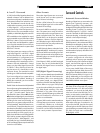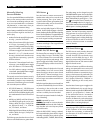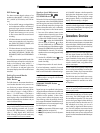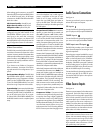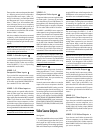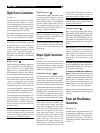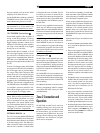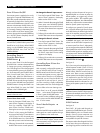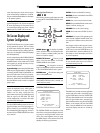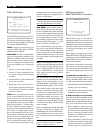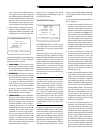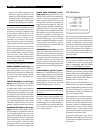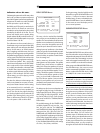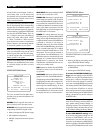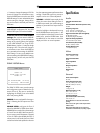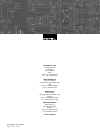
25
tion for older movie soundtracks that are
not of optimum audio quality. Compared
to the CINEMA setting, EMULATION mode
will reduce the high-frequency response and
separation of the surround channels and
may increase the delay setting to the sur-
round channels for a more spacious effect.
• Select MUSIC to optimize for musical re-
cordings. When the MUSIC mode is se-
lected, three additional parameter will be
available as shown in the following screen:
DOLBY PRO LOGIC II
MODE: Music
OPTIONAL PARAMETERS
PANORAMA: Off
DIMENSION: 3
CENTER WIDTH: 0
ENT KEY=input setup UP KEY=up
+/– KEY=change DWN KEY=down
Use the UP/DOWN keys on the remote to select
a parameter. Use the +/– keys to change the
selected parameter as follows:
• PANORAMA: The Panorama option
extends the front stereo image to include
the surround speakers for a dramatic “wrap-
around” effect. The options are OFF or ON.
• DIMENSION: The Dimension option al-
lows you to gradually adjust the soundfield
towards the front or towards the rear. There
are seven incremental settings from 0 to
6. A setting of 0 shifts the soundfield to-
wards the rear for maximum surround ef-
fect. A setting of 6 shifts the soundfield to
the front for minimum surround effect. The
default setting of 3 provides a “neutral”
balance between the two extremes.
• CENTER WIDTH: The Center Width option
allows you to send some of the signal in-
tended for the center speaker to the left and
right front speakers, thus widening the
perceived soundfield. There are eight in-
cremental settings from 0 to 7. With the
default setting of 0, there is no center width
spreading and all of the center channel
information is sent to the center speaker .
The maximum setting of 7 shifts all of the
center channel signal to the left and right
speakers, essentially muting the center
speaker and maximizing the soundfield
width. Other settings provide incremental
steps between the two extremes.
When you have completed all the desired
adjustments, press the ENTER key to return to
the INPUT SETUP menu.
SPEAKER SETUP Menu
SPEAKER SETUP
FRONT: Large
CENTER: Large
SURROUND: Large
CENTER BACK: Large
SUBWOOFER: Yes
CB SPKR SEL: 1 SPEAKER
ENT KEY=MAIN MENU UP KEY=up
+/– KEY=change DWN KEY=down
The SPEAKER SETUP menu is used to config-
ure the RSP-1066 for use with your specific
loudspeakers. The menu is accessed from the
MAIN menu.
Home theater systems vary in the number of
speakers and the bass capabilities of those
speakers. The RSP-1066 offers surround modes
tailored to systems with various numbers of
speakers and bass management features which
send bass information to the speaker(s) best
able to handle it – subwoofers and/or large
speakers. For optimum performance, you must
tell the RSP-1066 the number of speakers in
your system and how bass should be distrib-
uted among them.
NOTE
: There are two types of bass in a sur-
round sound system. The first is normal bass
recorded in each of the main channels (front,
center, and surround). This bass is present in
all recordings and soundtracks. In addition,
Dolby Digital 5.1 and DTS 5.1 recordings
have a Low Frequency Effects (LFE) channel –
the .1 channel. This bass channel, typically
played by a subwoofer, is used for effects
such as explosions or rumble. The use of the
LFE channel will vary from soundtrack to
soundtrack. Recordings that are not encoded
in Dolby Digital or DTS do not have the LFE
channel.
The following configuration instructions refer
to LARGE and SMALL speakers, referring more
to their desired bass configuration than their
physical size. Specifically, use the LARGE
setting for speakers that you want to play deep
bass signals. Use the SMALL designation for
speakers that would benefit from having their
bass sent to more capable speakers. The bass
management system redirects bass informa-
tion away from all SMALL speakers and sends
it to the LARGE speakers and/or the SUB-
WOOFER.
Four examples illustrate the principles behind
bass management:
• A system with five LARGE speakers and a
subwoofer: This system requires no bass
redirection. All five speakers play the nor-
mal bass recorded in their respective chan-
nels. The subwoofer plays only the LFE
channel bass. This may not be the most ef-
ficient use of system resources. Depend-
ing on the soundtrack, there may be mini-
mal use of the LFE channel, so the subwoofer
would be underutilized. Meanwhile the
normal bass places higher demands on the
capabilities of the other speakers and the
amplifiers driving them.
• A system with LARGE front, center, and
surround speakers, but no subwoofer. The
normal bass from the front, center, and
surround channels is played in its respec-
tive speakers. With no subwoofer, the LFE
bass is redirected to all five LARGE speak-
ers. This places significant demands on these
speakers and their amplifiers, as they must
play their own normal bass plus the very
demanding LFE bass.
• A system with LARGE front speakers, SMALL
center and surround speakers, and a sub-
woofer. The normal bass from the SMALL
center and surround speakers is redirected
to the LARGE front speakers and the sub-
woofer. The LARGE front speakers play their
own normal bass plus the redirected bass
from the SMALL speakers. The subwoofer
plays the LFE bass plus some of the redi-
rected bass from the SMALL center and
surround channels. This might be an ap-
propriate configuration with a pair of very
capable front speakers driven by a large
separate power amplifier.
• A system with all SMALL speakers and a
subwoofer. The normal bass from all chan-
nels is redirected to the subwoofer, which
also plays the LFE bass. The subwoofer
handles ALL of the bass in the system, while
the other speakers benefit from the added
dynamic range and reduced strain of not
having to play low bass. This configura-
tion realizes the full benefits of bi-amping:
bass is played by the speaker most suited
to do so, the other speakers play louder
with less distortion, and the need for am-
plifier power is reduced. This is the most
English



